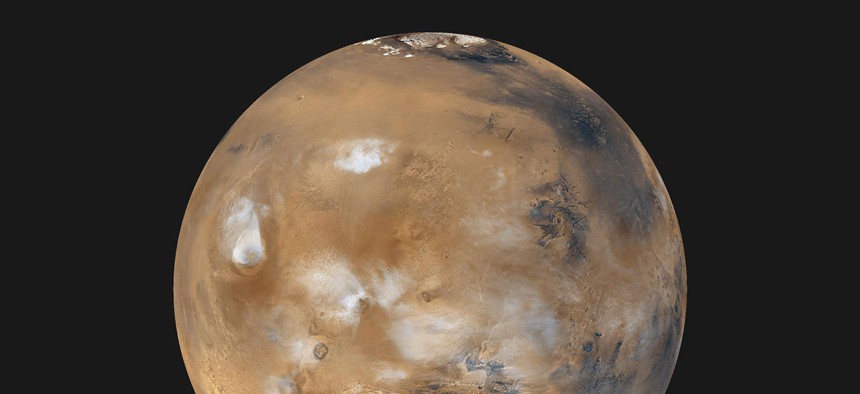Mars Once Had a Magnetic Field and an Ocean. Where Did They Go?
A new mission is setting out to discover what happened to aspects of the red planet.
The question of whether there is life on Mars is woven into a much larger thatch of mysteries. Among them: What happened to the ancient ocean that once covered a quarter of the planet’s surface? And, relatedly, what made Mars’s magnetosphere fade away? Why did a planet that may have looked something like Earth turn into a dry red husk?
“We see magnetized rocks on the Mars surface,” said Bruce Banerdt, the principal investigator of the InSight mission to Mars, which is set to launch in March. “And so we know Mars had a magnetic field at one time, but it doesn't today. We would like to know the history—when that magnetic field started, when it may have shut down.”
There are a few leading theories about what decimated the planet’s magnetism. One of them is that huge asteroids bombarded Mars until its magnetic field turned off. That storm of asteroids may have included one enormous rock in particular, even bigger than the one believed to have wiped out Earth’s dinosaurs.Another theory explores the possibility that Mars’s ancient magnetic field only ever covered one of its hemispheres, an idea that would also explain how the planet’s magnetism weakened over time. “The presence of a magnetic field is key to understanding the history of Mars’s atmosphere, which of course is key to habitability on Mars’s surface,” Banerdt told me.
To unpack what happened, scientists need to look far below the Martian surface. That’s why Banerdt’s team is planning to map Mars’s deep interior, seeking markers of “the evolution of the planet from a glob of meteorites into the complex world we see today.” The InSight lander will carry a seismometer, a heat probe, and a weather station to collect a cache of data. The goal is to discover, among other things, the planet’s composition, structure, the size and formation of its core, and the thickness of its crust.
“We’ve done a great job of exploring the geology on the surface. We’ve done pretty good job of studying the atmosphere today,” Banerdt said. “But what we’ve never really addressed in 40 years of Mars exploration is the deep interior and deep-interior processes. There’s this whole kind of blank area of our jigsaw puzzle, and it has connections to all the other things we're interested in.”
The InSight team will also track marsquakes caused by the planet buckling and squeezing as it cools. The expectation is that Mars will have less seismic activity than Earth but more than the moon. “We think we'll see somewhere between 50 and 100 marsquakes over the two-year life of our mission,” Banerdt said. “Something like one or two magnitude-6 marsquakes, and perhaps 10 times that many magnitude 5s, and 10 times that many magnitude 4s, and etcetera.”
Another big question for the team is the density of Mars’s core, which could help reveal what the core is made of—which could, in turn, help explain other phenomena on the planet. Knowing whether Mars has solid inner core surrounded by a molten outer core could unravel some of the mysteries about the planet’s magnetism and atmosphere. On Earth, the flow of liquid iron around a hotter solid core conducts electricity that helps keep the magnetic field in place. If Mars’s core is only molten, it could begin to explain the loss of magnetism that swept Mars’s primitive ocean out to space.
Scientists already have hints that Mars’s ancient magnetic field did not operate the way Earth’s does. And in 2007, one team of researchers made a model of the Martian core that suggested it might contain flecks of solid iron—a hint that the planet's magnetism could at some point re-activate.
But lab models only reveal so much. InSight will be able to gather unprecedented data from the interior of Mars. “It’s a new place, so we’re going to find new things,” Banerdt said. If all goes as planned, that will include information about the temperature beneath the surface of Mars, which scientists will collect via a heat probe that can burrow deep into the Martian soil.
The team will also track the wobbling of the Mars pole—which can help provide information about the size and density of the planet’s core—a calculation that requires determining the location of the InSight lander with a remarkable level of precision, down to a few inches. “Which is really crazy if you think of something that’s millions of miles away,” Banerdt said. “That sort of verges on magic as far as I’m concerned. But they’ve assured me it’s not magic. It’s science.”



